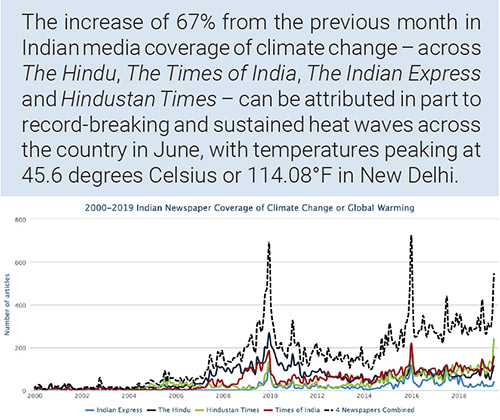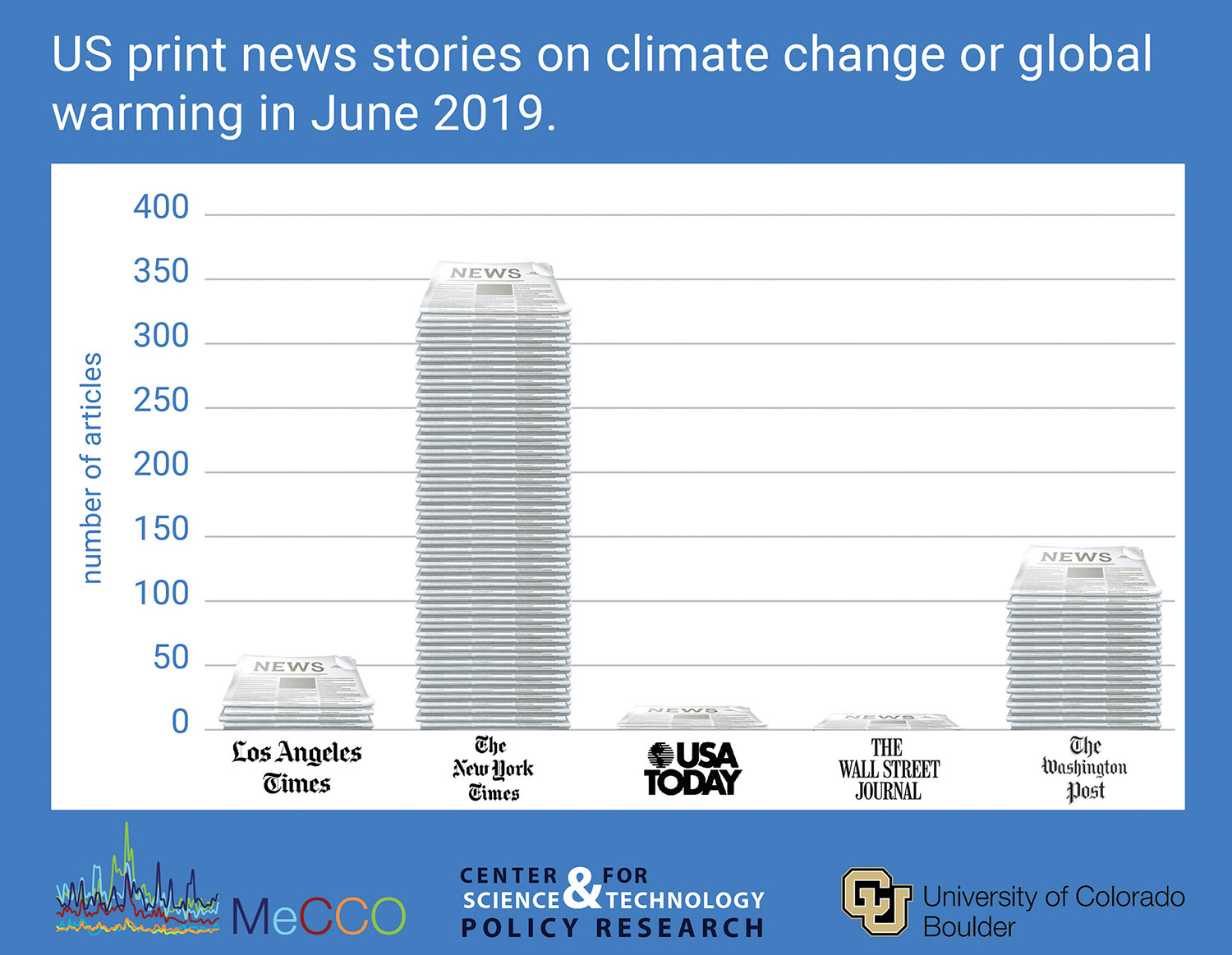Monthly Summaries
Issue 30, June 2019
[DOI]
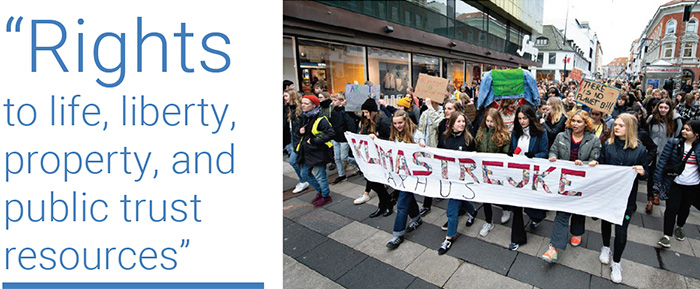
A rally in Aarhus, Denmark, protesting climate change. Photo: Henning Bagger/Ritzau Scanpix/Associated Press.
-
June media attention to climate change and global warming roughly doubled from June 2018, while trending slightly lower (-9%) from high levels in May 2019.
-
At the country level, coverage was notably up in Spain (+8%), Sweden (+8%), India (+67%) and through international wire services (+8%) as well as global radio segments (+26%) in June.
Figure 1 shows trends in newspaper media coverage at the global scale – organized into seven geographical regions around the world – from January 2004 through June 2019.
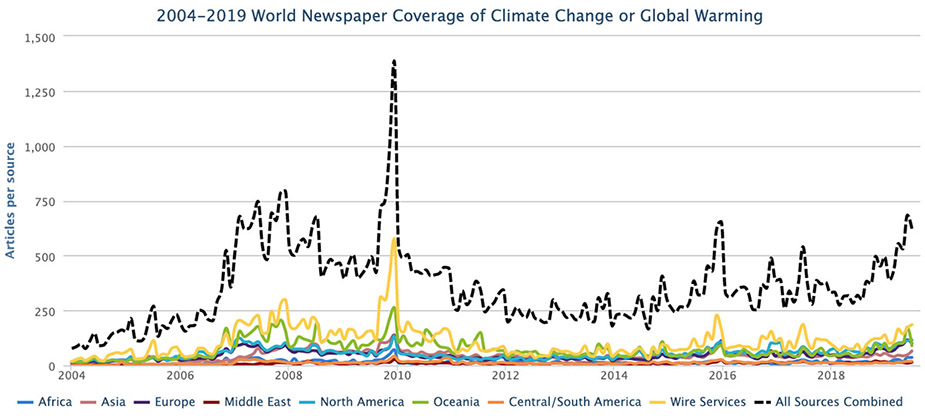
Figure 1. Newspaper media coverage of climate change or global warming in eight-three sources in seven different regions around the world, from January 2004 through June 2019.
Figure 2. Newspaper media coverage of climate change or global warming in 4 sources across India from January 2000 through June 2019. |
The increase of 67% from the previous month in Indian media coverage of climate change – across The Hindu, The Times of India, The Indian Express and the Hindustan Times – can be attributed in part to record-breaking and sustained heat waves across the country in June, with temperatures peaking at 45.6 degrees Celsius or 114.08°F in New Delhi. For example, journalist Jacob Koshny from The Hindu reported, “critical groundwater resources, which accounted for 40% of India’s water supply, are being depleted at ‘unsustainable’ rates and up to 70% of India’s water supply is ‘contaminated’”. Furthermore, an editorial from Hindustan Times noted, “India, in any case, is facing the worst water crisis in its history. According to NITI Aayog, by 2020, 100 million will be affected by a shortage of groundwater in 21 Indian cities. And about 40% of the population will have no access to drinking water by 2030. It's not too difficult to discern why India is facing such an acute crisis. A report released by McGill University and Utrecht University blames irrigation techniques, industrial and residential habits combined with climate change for this problem”. Stories of severe heat compounding existing drought and water scarcity issues throughout India (and particularly in Northern India) provided news hooks for media stories. Also, stories of declining water levels in the India, Ganga and Brahmaputra basins, partly attributed to the rapid retreat of the Himalayan glaciers feeding these river basins generated media attention in India. And the impacts of heat waves on energy demands, particularly in cities, drove increased coverage.
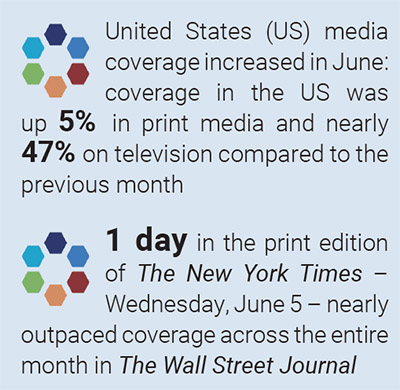 In addition, United States (US) media coverage increased in June: coverage in the US was up 5% in print media and nearly 47% on television compared to the previous month. When this increase across outlets is disaggregated, one can detect a slightly different set of trends (see Figure 3). These show that in fact most of these increases are due to increased coverage at The New York Times followed by increases at The Washington Post in print, and on CNN, Fox News and MSNBC in television, coverage. In fact, these increases across US media coverage of climate change in recent months are occurring in spite of rather than because of more abundant coverage in the leading US network news organizations – ABC News, CBS News, NBC News, and PBS Newshour* – along with US prestige press outlets – The Wall Street Journal and USA Today.
In addition, United States (US) media coverage increased in June: coverage in the US was up 5% in print media and nearly 47% on television compared to the previous month. When this increase across outlets is disaggregated, one can detect a slightly different set of trends (see Figure 3). These show that in fact most of these increases are due to increased coverage at The New York Times followed by increases at The Washington Post in print, and on CNN, Fox News and MSNBC in television, coverage. In fact, these increases across US media coverage of climate change in recent months are occurring in spite of rather than because of more abundant coverage in the leading US network news organizations – ABC News, CBS News, NBC News, and PBS Newshour* – along with US prestige press outlets – The Wall Street Journal and USA Today.
*Lower levels of US networks television coverage compared to the cable outlets can be explained in part by a more limited news hole. We at MeCCO continue to work to develop a way to normalize for those differences.
Figure 3. Number of news stories in June 2019 across US newspapers (The Washington Post, The Wall Street Journal, The New York Times, USA Today, and Los Angeles Times). |
For example, one day in the print edition of The New York Times – Wednesday, June 5 – nearly outpaced coverage across the entire month in The Wall Street Journal (which carried a total of 11 stories in June). Stories on that day addressed issues associated with climate change including ‘Biden’s Plan for Climate Action Goes Beyond Obama’s Goals’ on the front page above the fold, international news of the Danish elections and how “climate and immigration fuel the divide” (page A5), news of protests in London to US President Trump’s visit, with mention by journalist Ceylan Yeginsu of one placard on the street reading ‘climate change is real, your tan is not’ (page A6), a story about climate change motivating France to end the disposal of $900 million in unsold goods each year (page A8), coverage of an ongoing US federal court case regarding whether young people have a constitutional right to be protected from climate change (page A10), a story by reporter Kendra Pierre-Louis on research into avoided deaths associated with climate mitigation and adaptation commitments in line with the Paris Agreement (page A20), a Nicholas Kristof op-ed addressing the role of climate change in migration patterns (page A26), and story by journalist Brad Plumer entitled ‘Companies Expect to Feel Climate Change’s Bite in 5 years’ (page B4).
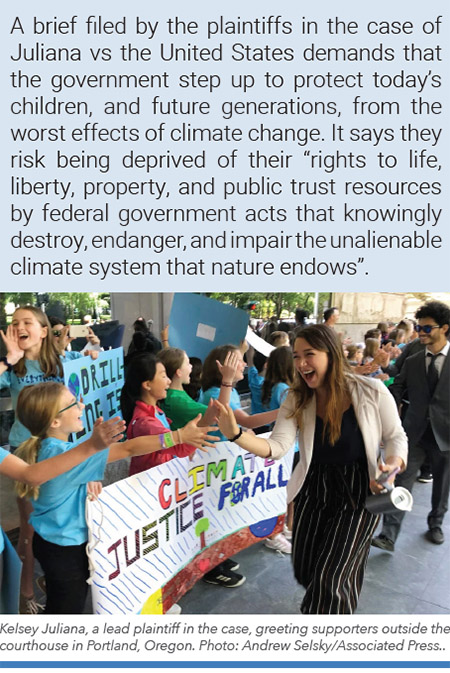 Amid media attention paid to cultural dimensions of climate change and global warming in the month of June, the aforementioned Federal court case (called ‘Juliana vs the United States’) garnered media attention. For example, journalist John Schwartz from The New York Times noted that the ongoing case in the US Ninth Circuit Court of Appeals “was scheduled to begin last October, but the court granted the Trump administration an unusual pretrial appeal. Their decision could have important implications for this and other attempts to use the courts to pursue climate action across the United States. A brief filed by the plaintiffs in the case of Juliana vs the United States demands that the government step up to protect today’s children, and future generations, from the worst effects of climate change. It says they risk being deprived of their “rights to life, liberty, property, and public trust resources by federal government acts that knowingly destroy, endanger, and impair the unalienable climate system that nature endows”.
Amid media attention paid to cultural dimensions of climate change and global warming in the month of June, the aforementioned Federal court case (called ‘Juliana vs the United States’) garnered media attention. For example, journalist John Schwartz from The New York Times noted that the ongoing case in the US Ninth Circuit Court of Appeals “was scheduled to begin last October, but the court granted the Trump administration an unusual pretrial appeal. Their decision could have important implications for this and other attempts to use the courts to pursue climate action across the United States. A brief filed by the plaintiffs in the case of Juliana vs the United States demands that the government step up to protect today’s children, and future generations, from the worst effects of climate change. It says they risk being deprived of their “rights to life, liberty, property, and public trust resources by federal government acts that knowingly destroy, endanger, and impair the unalienable climate system that nature endows”.
In addition, a Guardian weekend special section at the end of the month of June covered a number of stories from a conversation with Greta Thunberg and Alexandria Ocasio-Cortez, a story on a fast-warming Artic town called Longyearbyen and a feature on how climate experts have made changes in their own lives. This fed into increased coverage in the UK in June, along with burgeoning coverage in The Times (London) and Sunday Times particularly as June came to a close.
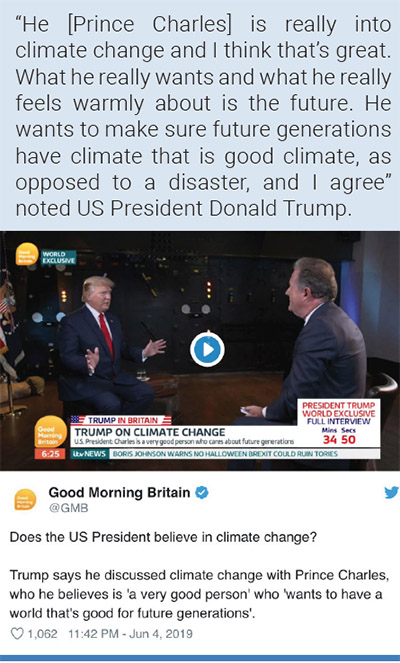 There were many other media stories addressing political and economic connections with climate issues around the world. For example, to start the month of June, US President Trump’s visit to the UK sparked media attention as it related to his climate stance and his take on intergenerational equity. Also, journalists Matthew Weaver and Kate Lyons from The Guardian, reported “Prince Charles spent 75 minutes longer than scheduled trying to convince Donald Trump of the dangers of global heating, but the president still insisted the US was “clean” and blamed other nations for the crisis. Trump told ITV’s Good Morning Britain on Wednesday he had been due to meet the Prince of Wales for 15 minutes during his state visit, but the discussion went on for 90 minutes – during which the prince did “most of the talking”. “He [Prince Charles] is really into climate change and I think that’s great. What he really wants and what he really feels warmly about is the future. He wants to make sure future generations have climate that is good climate, as opposed to a disaster, and I agree” noted US President Donald Trump. However, a number of his other comments to Piers Morgan on ITV (and reported elsewhere in the media during Trump’s visit) prompted Washington Post national correspondent Philip Bump to ask ‘Does Trump Understand How Global Warming Works?’ Pulling a quote from Trump in his piece that “I did say, well, the United States right now has among the cleanest climates there are, based on all statistics, and it’s even getting better. Because I agree with that. I want the best water, the cleanest water. Crystal clean, has to be crystal clean air”, Bump noted, “He appears instead to be talking about old-school 1970s-era pollution: smog and soot and so on. That’s also a problem, certainly, particularly in cities in China and India. It often stems from the same electricity production that generates carbon-dioxide emissions. But it’s not what we’re talking about when we talk about climate change”.
There were many other media stories addressing political and economic connections with climate issues around the world. For example, to start the month of June, US President Trump’s visit to the UK sparked media attention as it related to his climate stance and his take on intergenerational equity. Also, journalists Matthew Weaver and Kate Lyons from The Guardian, reported “Prince Charles spent 75 minutes longer than scheduled trying to convince Donald Trump of the dangers of global heating, but the president still insisted the US was “clean” and blamed other nations for the crisis. Trump told ITV’s Good Morning Britain on Wednesday he had been due to meet the Prince of Wales for 15 minutes during his state visit, but the discussion went on for 90 minutes – during which the prince did “most of the talking”. “He [Prince Charles] is really into climate change and I think that’s great. What he really wants and what he really feels warmly about is the future. He wants to make sure future generations have climate that is good climate, as opposed to a disaster, and I agree” noted US President Donald Trump. However, a number of his other comments to Piers Morgan on ITV (and reported elsewhere in the media during Trump’s visit) prompted Washington Post national correspondent Philip Bump to ask ‘Does Trump Understand How Global Warming Works?’ Pulling a quote from Trump in his piece that “I did say, well, the United States right now has among the cleanest climates there are, based on all statistics, and it’s even getting better. Because I agree with that. I want the best water, the cleanest water. Crystal clean, has to be crystal clean air”, Bump noted, “He appears instead to be talking about old-school 1970s-era pollution: smog and soot and so on. That’s also a problem, certainly, particularly in cities in China and India. It often stems from the same electricity production that generates carbon-dioxide emissions. But it’s not what we’re talking about when we talk about climate change”.
As another example, back on US soil during the month, US presidential hopefuls continued to roll out climate plans: these, in turn, generated media coverage. For instance, leading Democratic hopeful and former Vice President Joe Biden released his plan. Stories focused on the plan itself as well as on reactions to the ‘middle ground approach’. For example, journalists Dino Grandoni and Jeff Stein from The Washington Post wrote on June 4, “Joe Biden is embracing the framework of the Green New Deal in his bid for the White House, calling on the United States to eliminate climate-warming emissions by no later than the middle of the century while creating millions of new jobs and rallying the rest of the world to forestall dangerous rising temperatures. Biden released a 22-page climate plan Tuesday that appears at least in part aimed at blunting the criticisms of environmentalists and others on the left who have argued Biden’s 2020 presidential campaign is out of step with the current Democratic Party. With the former vice president consistently leading in the polling, the Democratic Party’s left flank has leveled broader critiques of Biden’s record and campaign policies, including his vote for the Iraq War as a senator and his support for a public option rather than the universal “Medicare-for-all” plan”. Associated Press reporter Bill Barrow also noted that he is “pitching a $5 trillion-plus climate proposal that he says would lead the U.S. to net zero emission of carbon pollution by 2050. The former vice president calls for $1.7 trillion in federal spending over 10 years, with the rest of the investments coming from the private sector. Biden proposes covering the taxpayer costs by repealing the corporate tax cuts that President Donald Trump signed in 2017, while eliminating existing subsidies to the fossil fuel companies. Biden's plan — a mix of tax incentives, federal spending, new regulation and more aggressive foreign policy on climate issues —comes as he pushes back on rivals' assertions that his environmental agenda isn't bold enough. Climate activists largely praised his pitch Tuesday, although some said the Democrats' 2020 front-runner still hasn't gone far enough to challenge the fossil fuel industry. His proposal calls the Green New Deal pushed by some Democrats on Capitol Hill "a crucial outline" but stops short of some of its timelines for weaning the U.S. economy off power from fossil fuels, even as he promises a "clean energy revolution" nationwide and internationally".
Meanwhile, Senator Elizabeth Warren (also a Democratic Presidential hopeful) released a set of plans to confront climate change. These prompted stories about the plan and comparing/contrasting hers with Joe Biden’s and others’. For example, journalist Ken Thomas compared it to the Joe Biden plan in the pages of The Wall Street Journal, while Reuters journalist Ginger Gibson wrote, “Democratic U.S. presidential hopeful Elizabeth Warren proposed on Tuesday spending $2 trillion on a new "green manufacturing" program to address climate change that would invest in research and exporting American clean energy technology. The manufacturing program is the first in a new series of "economic patriotism" proposals Warren is unveiling intended to create American jobs and help U.S. industry. "This is going to be a big plan for bold structural changes," Warren said at a campaign rally in Detroit, Michigan. Warren told the crowd of about 500 in a facility that teaches manufacturing skills that her proposal would be paid for by cutting subsidies in the oil and gas industry. Additionally, by all companies paying more taxes, she said, singling out Amazon.com. Among the more than 20 Democrats in the field hoping to challenge Republican President Donald Trump in November 2020, Warren has distinguished herself as the most prolific proposer of new policy positions”. Meanwhile, New York Times journalists Astead Herndon and Patricia Cohen noted the Senator Warren’s plan “would invest $2 trillion in climate-friendly industries over a decade, create a new cabinet-level Department of Economic Development and even manipulate the dollar to promote exports”.
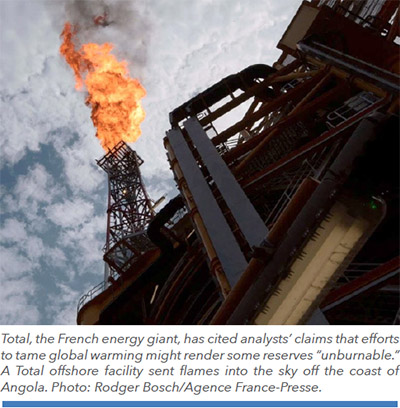 Other stories in June focused more squarely on economics. For example, there were numerous media reports on a new analysis of corporate disclosures by the Carbon Disclosure Project. Journalist Matthew Green from Reuters reported, “More than 200 of the world’s largest listed companies forecast that climate change could cost them a combined total of almost $1 trillion, with much of the pain due in the next five years, according to a report published on Tuesday. Even so, the findings by charity CDP suggested many companies still underestimated the dangers as scientists warn that earth’s climate system is on course to hit catastrophic tipping points without rapid cuts in carbon emissions”. Furthermore, New York Times reporter Brad Plumer wrote, “Under pressure from shareholders and regulators, companies are increasingly disclosing the specific financial impacts they could face as the planet warms, such as extreme weather that could disrupt their supply chains or stricter climate regulations that could hurt the value of coal, oil and gas investments. Early estimates suggest that trillions of dollars may ultimately be at stake. Even so, analysts warn that many companies are still lagging in accounting for all of the plausible financial risks from global warming”.
Other stories in June focused more squarely on economics. For example, there were numerous media reports on a new analysis of corporate disclosures by the Carbon Disclosure Project. Journalist Matthew Green from Reuters reported, “More than 200 of the world’s largest listed companies forecast that climate change could cost them a combined total of almost $1 trillion, with much of the pain due in the next five years, according to a report published on Tuesday. Even so, the findings by charity CDP suggested many companies still underestimated the dangers as scientists warn that earth’s climate system is on course to hit catastrophic tipping points without rapid cuts in carbon emissions”. Furthermore, New York Times reporter Brad Plumer wrote, “Under pressure from shareholders and regulators, companies are increasingly disclosing the specific financial impacts they could face as the planet warms, such as extreme weather that could disrupt their supply chains or stricter climate regulations that could hurt the value of coal, oil and gas investments. Early estimates suggest that trillions of dollars may ultimately be at stake. Even so, analysts warn that many companies are still lagging in accounting for all of the plausible financial risks from global warming”.
In mid-June, a European Union failure to agree on a carbon-neutral proposal for 2050 generated media attention. For instance, Associated Press reporters Samuel Petrequin and Raf Casert reported, “European Union leaders failed Thursday to back a plan to make the bloc’s economy carbon neutral by 2050 in spite of promises to protesters across the continent to fight harder against climate change. Ahead of a U.N. meeting in the fall, the proposal was relegated to a non-binding footnote in the final statement of Thursday’s summit of EU leaders in Brussels. “For a large majority of Member States, climate neutrality must be achieved by 2050,” the footnote read. “However, for the change in approach to become an official target, all 28 EU countries need to back the change. The non-decision showed the rift between the western member states and the eastern nations on climate change. According to French president Emmanuel Macron and several other diplomatic sources, 24 countries including Britain, France and Germany supported the initiative, but were held back by Poland and three other nations which heavily depend on a fossil-fuel economy”.
Later in June, the first round of US Democratic Primary Presidential Debates also generated attention (as much for the absence of climate change discussions as their presence), along with the United Nations Climate Conference – the fiftieth sessions of the Subsidiary Body for Scientific and Technological Advice and the Subsidiary Body (SB 50) for Implementation – in Bonn, Germany generated media coverage.
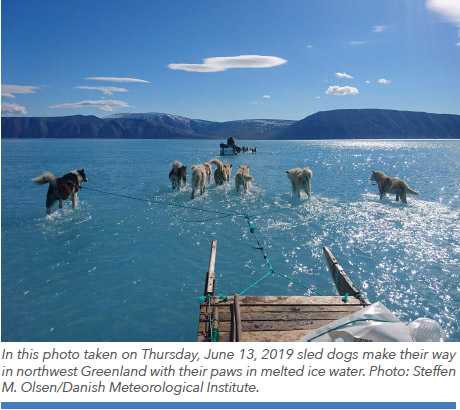 In June, ecological and meteorological content also shaped overall media coverage throughout the month. Of note, a photograph of dogs pulling a sled through melted water in Greenland made it to many news reports and print media due to the striking image of warming. Stories that accompanied the shot described ice loss due to ‘unseasonably’ high Arctic temperatures. For example, CNN meteorologist Brandon Miller reported, “Over 40% of Greenland experienced melting Thursday, with total ice loss estimated to be more than 2 gigatons (equal to 2 billion tons) on just that day alone. While Greenland is a big island filled with lots of ice, it is highly unusual for that much ice to be lost in the middle of June. The average ‘melt season’ for Greenland runs from June to August, with the bulk of the melting occurring in July. To visualize how much ice that is, imagine filling the National Mall in Washington with enough ice to reach a point in the sky eight times higher than the Washington Monument (to borrow an analogy Meredith Nettles from Columbia University gave to The Washington Post)…This much melting this early in the summer could be a bad sign, indicating 2019 could once again set records for the amount of Greenland ice loss”. Meanwhile, journalist Henry Fountain from The New York Times wrote, “The Arctic spring thaw has begun with a bang, with extensive melting of the Greenland ice sheet and sea ice loss that is already several weeks ahead of normal, scientists said. A stagnant zone of high-pressure air over Greenland last week brought warm air from the south, raising temperatures as much as 40 degrees Fahrenheit above normal. That, coupled with cloudless conditions, led to a pulse of melting across much of the ice sheet surface. Melting last Wednesday was the most extensive, at 275,000 square miles, or about 45 percent of the surface ...”
In June, ecological and meteorological content also shaped overall media coverage throughout the month. Of note, a photograph of dogs pulling a sled through melted water in Greenland made it to many news reports and print media due to the striking image of warming. Stories that accompanied the shot described ice loss due to ‘unseasonably’ high Arctic temperatures. For example, CNN meteorologist Brandon Miller reported, “Over 40% of Greenland experienced melting Thursday, with total ice loss estimated to be more than 2 gigatons (equal to 2 billion tons) on just that day alone. While Greenland is a big island filled with lots of ice, it is highly unusual for that much ice to be lost in the middle of June. The average ‘melt season’ for Greenland runs from June to August, with the bulk of the melting occurring in July. To visualize how much ice that is, imagine filling the National Mall in Washington with enough ice to reach a point in the sky eight times higher than the Washington Monument (to borrow an analogy Meredith Nettles from Columbia University gave to The Washington Post)…This much melting this early in the summer could be a bad sign, indicating 2019 could once again set records for the amount of Greenland ice loss”. Meanwhile, journalist Henry Fountain from The New York Times wrote, “The Arctic spring thaw has begun with a bang, with extensive melting of the Greenland ice sheet and sea ice loss that is already several weeks ahead of normal, scientists said. A stagnant zone of high-pressure air over Greenland last week brought warm air from the south, raising temperatures as much as 40 degrees Fahrenheit above normal. That, coupled with cloudless conditions, led to a pulse of melting across much of the ice sheet surface. Melting last Wednesday was the most extensive, at 275,000 square miles, or about 45 percent of the surface ...”
Across the globe in June, many news stories also focused on scientific themes. Among them, a study of Himalayan glaciers published in the journal Science Advances prompted a number of news stories in June. For example, journalist Jeff Berardelli from CBS News reported, “Keeping watch over ice on the Himalayan glaciers was certainly not the intended mission of a U.S. spy satellite program, called Hexagon, which operated from 1971 to 1986. Nevertheless, the declassified photos have revealed a rapid acceleration of Himalayan ice melt — doubling in just one generation. A new study by Columbia University's Earth Institute finds the glaciers have been losing 20 vertical inches of ice per year since 2000, double the rate of the late 20th century. To put that into perspective, the recent amount of ice lost each year is enough to fill 3.2 million Olympic-size swimming pools and more than enough to supply drinking water to every person on Earth for longer than a lifetime. To reach these conclusions, lead author Joshua Maurer and his team took a unique approach. They analyzed 40 years of satellite images of 650 glaciers spanning 1,200 miles across India, China, Nepal and Bhutan. Much of the 20th-century data came from images taken by U.S. spy satellites. The researchers then created a system to automatically turn these images into 3D models in order to measure the changing elevations of glaciers over time. They then compared these images with more recent data from newer satellites to determine ice volume changes”.
Also among them, a study examining heat deaths in major US cities in the future grabbed media interest. USA Today journalist Doyle Rice wrote, “Deadly summer heat will get worse as the globe warms, so putting the brakes on climate change by reducing carbon emissions will literally be a lifesaver for thousands of Americans, a new study suggests. In fact, researchers report that limiting global warming could drastically lower deaths in most of the 15 U.S. cities studied”. Meanwhile, reporter Emily Baumgaertner from the Los Angeles Times noted, “For decades, climate scientists have been designing models to predict global warming’s long-term ecological effects: sea level rise, coral bleaching, extinctions of entire species. Researchers have now taken a step that hits closer to home, characterizing for the first time how various climate scenarios outlined in the Paris agreement could affect heat-related deaths in humans. Spoiler alert: The results range from horrible to only marginally less horrible. If no change is made to current climate commitments, the global average temperature could rise 3 degrees Celsius above pre-industrial levels by the year 2100, and with it will come the type of extreme heat waves that are expected to occur once every 30 years. Researchers predict about 20,240 heat-related deaths across 15 U.S. cities whenever such an event occurs. But by limiting that temperature change to 2 or even 1.5 degrees Celsius — the goal of the Paris agreement — humans could prevent between 6,232 and 9,484 of those deaths, according to the research published Wednesday in the journal Science Advances”.
Going forward, our international MeCCO team carries on monitoring and analyzing political, economic, scientific, cultural, ecological and meteorological stories as they unfold. We will continue to keep you posted, too.

